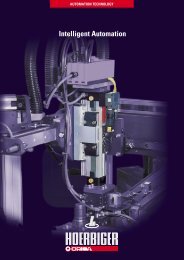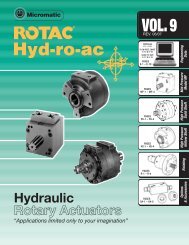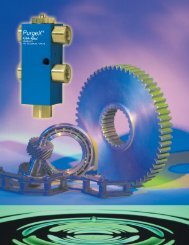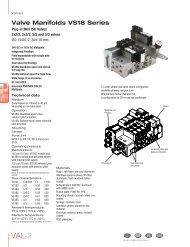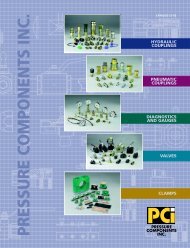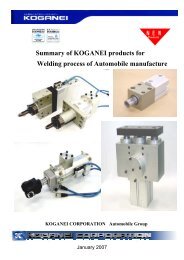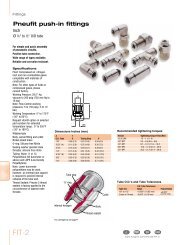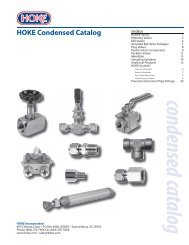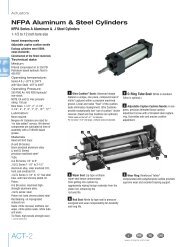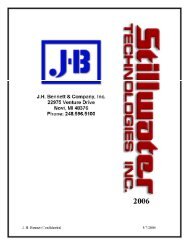Canfield Connector Buyer's Guide
Canfield Connector Buyer's Guide
Canfield Connector Buyer's Guide
You also want an ePaper? Increase the reach of your titles
YUMPU automatically turns print PDFs into web optimized ePapers that Google loves.
Typical Application and Installation<br />
Resistance Welding<br />
Many resistance welders used in<br />
the automotive industry rely on<br />
proximity devices in order to<br />
sequence the force, time and<br />
current needed to produce welds.<br />
EOS Advantage: Since the<br />
EOS adjusts to finite triggering<br />
based on cylinder (tactile) force,<br />
precise trip points based on those<br />
forces save time to weld. The<br />
reason for this is that the weld can be accomplished without<br />
the need to add time frames for flow restrictions and pressure<br />
drops inherent in each system. The EOS also remains<br />
unaffected by weld fields as the principle of operation and<br />
does not use magnetism or inductive sensing. Additionally,<br />
differing thicknesses of metals and weld tip erosion can not<br />
change the trip points of the EOS. The EOS can be mounted<br />
either at or away from the cylinder. The EOS will not trip in low<br />
pressure situations as proximity sensors would ensuring<br />
quality welds. The EOS is also available with an SPC output<br />
In the DC version. Pressure profiles can be fed back into a<br />
computer data acquisition terminal where the pressure profiles<br />
for each individual weld can be stored for quality assurance.<br />
Automatic Door Closing<br />
and Obstacle Sensing<br />
Some doors and covers which are<br />
used to separate rooms in plants or<br />
sections of machinery are closed by<br />
use of air cylinders.<br />
EOS Advantage: An EOS<br />
attached to the circuit replaces<br />
electric eyes and tape switches.<br />
Setting the EOS to the proper<br />
force, an obstacle of varying sizes<br />
can be placed anywhere along the path of the door. A resistance<br />
great enough to create a pressure differential signals the<br />
control that an obstacle is in the way of normal travel which in<br />
turn reverses the travel of the door. A conventional proximity<br />
device is in place at the end of the door travel which negates<br />
the EOS output and signals to the control that the door is in<br />
fact closed. The EOS gives the door a tactile response. In this<br />
application the EOS is simply a single component of a more<br />
elaborate safety system.<br />
How It Works<br />
(Refer to schematic figure 1 and graph figure 2)<br />
1 Four way valve shifts switching pressure from port “A” to<br />
port “B”.<br />
PORT A<br />
2 Pressure builds in line “B” and drops in line “A” until cylinder<br />
load / friction are overcome.<br />
3 Dependent upon the response time and valve flow, “B” line<br />
pressure exceeds “A” line pressure.<br />
PRESSURE (PSI)<br />
PORT B<br />
4 Friction / load overcome, cylinder travel begins.<br />
5 End of stroke or clamping force begins, “B” line pressure<br />
increases and “A” line pressure decays.<br />
6 When the pressure differential between port “A” and “B”<br />
(B PSI - A PSI = ∆p) increases to the preset trip point<br />
output “B” will activate.<br />
TIME<br />
Figure 2<br />
The sensor can be set to trip anywhere in<br />
the shaded region depending on desired<br />
clamping force and/or delay.<br />
Ordering Information<br />
E O S - 1<br />
EOS<br />
Supply Voltage<br />
1 - 12-24 VDC<br />
2 - 24-48 VAC *<br />
3 - 120 VAC *<br />
Cordset<br />
0 - Without Cordset<br />
1 - With 6 ft Straight Female Cordset<br />
2 - With 6 ft 90° Female Cordset<br />
Module Style<br />
0 - Module Only<br />
1 - Module and Standard Sub-Base<br />
* AC voltage versions are not available with analog output<br />
67



